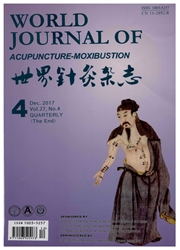

 中文摘要:
中文摘要:
目的:探讨针刺对大鼠成瘾记忆的影响。方法:采用递增量结合水迷宫平台上注射海洛因,伴高频声音线索,建立海洛因复吸大鼠成瘾模型。模型成功后,将大鼠分为4组:蛋白组、复吸组、针刺组、药物组,每组10片。针刺组取穴为“百会”穴和“大椎”穴,药物组采用美沙酮灌胃治疗。采用Morris水迷宫观察记录大鼠上平台时间和游泳距离,运用免疫组化法观察海马CA1区AFosB和cAMP反应元件结合蛋白(cAMP response element binding protein,CREB)的表达。结果:第3次治疗后,针刺组潜伏期和游泳总距离延长,与复吸组相比,差异具有统计学意义(P〈0.05);针刺组与复吸组比较,AFosB和CREB表达均减少,差异具有统计学意义(P〈0.05)。结论:针刺下调海洛因复吸大鼠海马△FosB和CREB表达水平,对成瘾记忆具有一定抑制作用。
 英文摘要:
英文摘要:
Objective To investigate the effect of acupuncture on the addiction memory of rats. Methods A model for heroin re-addicted rats was made by coupling heroin injection in increasing doses on the platform of a Morris water maze with high-frequency sounds cues. The animals were randomly divided into control group, relapse group, acupuncture group, and drug group, with 10 individuals in each group. For the acupuncture group, Baihui (百会 GV 20) and "Dazhui" (大椎 GV 24) were selected. Morris water maze was used to assess the time elapsed and the distance traveled before a rat reached the platform. The expression levels of A FosB and cAMP response element binding protein (CREB) in hippocampal CA 1 area were assessed with immunohistochemical staining. Results Upon completion of three treatments, the acupuncture group had significantly longer lengths of latency and swimming distance compared to the relapse group (P〈0.05). Furthermore, the acupuncture group had significantly lowered expression levels of A FosB and CREB compared to the relapse group (P〈0.05). Conclusion Acupuncture can downregulate A FosB and CREB expression in rats' hippocampal area and inhibit the addiction memory.
 同期刊论文项目
同期刊论文项目
 同项目期刊论文
同项目期刊论文
 期刊信息
期刊信息
